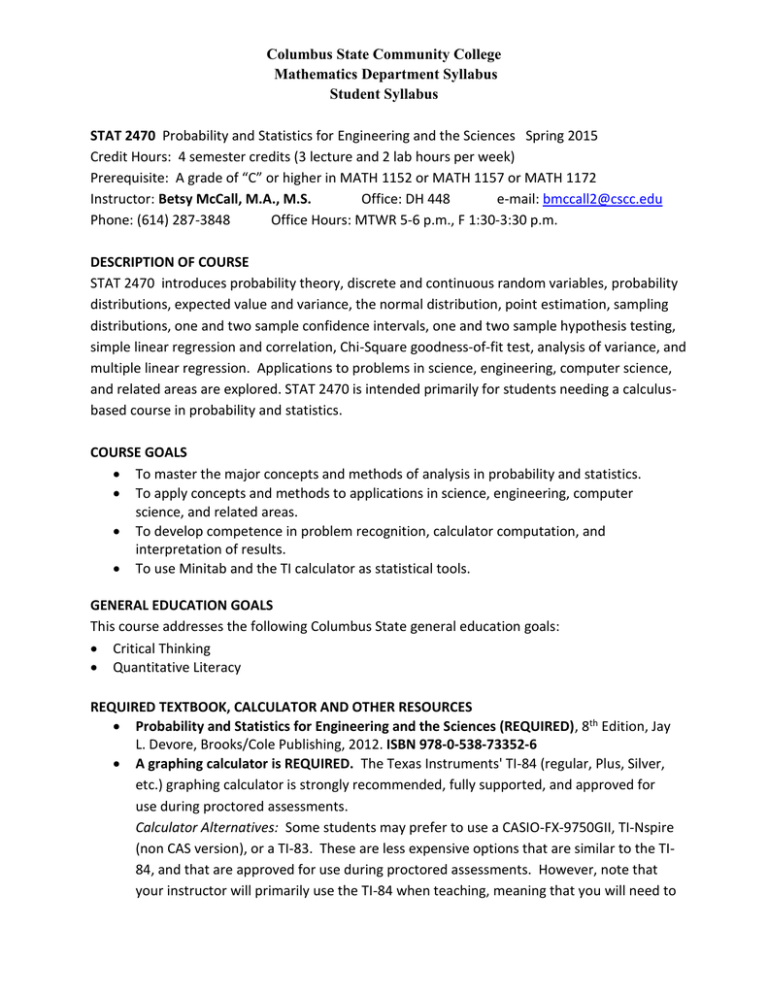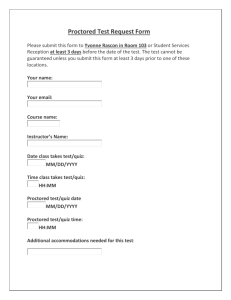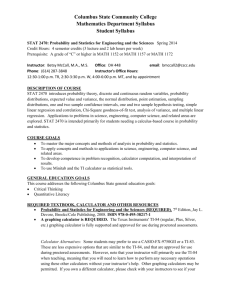Syllabus - BetsyMcCall.net
advertisement

Columbus State Community College Mathematics Department Syllabus Student Syllabus STAT 2470 Probability and Statistics for Engineering and the Sciences Spring 2015 Credit Hours: 4 semester credits (3 lecture and 2 lab hours per week) Prerequisite: A grade of “C” or higher in MATH 1152 or MATH 1157 or MATH 1172 Instructor: Betsy McCall, M.A., M.S. Office: DH 448 e-mail: bmccall2@cscc.edu Phone: (614) 287-3848 Office Hours: MTWR 5-6 p.m., F 1:30-3:30 p.m. DESCRIPTION OF COURSE STAT 2470 introduces probability theory, discrete and continuous random variables, probability distributions, expected value and variance, the normal distribution, point estimation, sampling distributions, one and two sample confidence intervals, one and two sample hypothesis testing, simple linear regression and correlation, Chi-Square goodness-of-fit test, analysis of variance, and multiple linear regression. Applications to problems in science, engineering, computer science, and related areas are explored. STAT 2470 is intended primarily for students needing a calculusbased course in probability and statistics. COURSE GOALS To master the major concepts and methods of analysis in probability and statistics. To apply concepts and methods to applications in science, engineering, computer science, and related areas. To develop competence in problem recognition, calculator computation, and interpretation of results. To use Minitab and the TI calculator as statistical tools. GENERAL EDUCATION GOALS This course addresses the following Columbus State general education goals: Critical Thinking Quantitative Literacy REQUIRED TEXTBOOK, CALCULATOR AND OTHER RESOURCES Probability and Statistics for Engineering and the Sciences (REQUIRED), 8th Edition, Jay L. Devore, Brooks/Cole Publishing, 2012. ISBN 978-0-538-73352-6 A graphing calculator is REQUIRED. The Texas Instruments' TI-84 (regular, Plus, Silver, etc.) graphing calculator is strongly recommended, fully supported, and approved for use during proctored assessments. Calculator Alternatives: Some students may prefer to use a CASIO-FX-9750GII, TI-Nspire (non CAS version), or a TI-83. These are less expensive options that are similar to the TI84, and that are approved for use during proctored assessments. However, note that your instructor will primarily use the TI-84 when teaching, meaning that you will need to learn how to perform any necessary operations, using these other calculators, without your instructor’s help. Other graphing calculators may be permitted. If you own a different calculator, please check with your current instructor to see if your calculator will be allowed during their proctored assessments. The TI-89, TI-92, TI-Nspire CAS, or other Computer Algebra System (CAS) calculators, are never allowed during proctored assessments. Your instructor may require that your graphing calculator’s memory be reset (all RAM cleared) prior to each proctored assessment. The Columbus State Bookstore sells both the TI-84 and CASIO-FX-9750GII for your convenience. Additional resources supporting the use of the TI-84 and CASIO-FX-9750GII may be available at: http://www.cscc.edu/academics/departments/math/graphing-calculator.shtml. Tutoring is available in the Learning Resource Center. See http://www2.cscc.edu/academics/departments/math/tutoring.shtml for location and posted hours. NOTE TO STUDENTS To achieve a mastery of the course material, the Mathematics Department recommends that the student should be prepared to spend an average of 12 hours per week on this course. INSTRUCTIONAL METHODS Classroom lecture, discussion, and recitations supplemented by calculator and software demonstrations as appropriate. UNITS OF INSTRUCTION 1. Descriptive Statistics (1.3-1.4) 2. Probability (2.1-2.5) 3. Discrete Random Variables (3.1-3.6) 4. Continuous Random Variables (4.1-4.4) 5. Joint Probability Distributions (5.1-5.4) 6. Point Estimation (6.1-6.2) 7. Statistical Intervals Based on a Single Sample (7.1-7.3) 8. Tests of Hypothesis Based on a Single Sample (8.1-8.4) 9. Inferences Based on Two Samples (9.1-9.4) 10. The Analysis of Variance (10.1-10.2) 11. Simple Linear Regression and Correlation (12.1-12.5) 12. Multiple Regression (13.1-13.4) 13. Goodness-of-Fit Tests and Categorical Data Analysis (14.1-14.2) METHODS OF EVALUATION Letter grades for the course will be awarded using a 90%-80%-70%-60% scale (900-800-700-600 point scale). 20% (200 points) Final Exam (comprehensive). 10% (100 points) Lab exercises. 10% (100 points) for Homework (Section Exercises) 13% (130 points) for each of 3 Midterm Exams 10% (100 points) for Final Project 11% (110 points) for Quizzes ATTENDANCE AND MAKE-UP POLICY Quizzes will be given frequently in class, and they may not be made up, so attendance is essential. Late homework and handouts will be accepted but with a 50% reduction in credit once the answer key is posted. Missed exams may be rescheduled in advance, if necessary, with sufficient notice. Missed exams rescheduled after the exam date will only be counted toward the final grade with sufficient documentation of a reasonable emergency excuse. ASSESSMENT Columbus State Community College is committed to assessment (measurement) of student achievement of academic outcomes. This process addresses the issues of what you need to learn in your program of study and if you are learning what you need to learn. The assessment program at Columbus State has four specific and interrelated purposes: (1) to improve student academic achievements; (2) to improve teaching strategies; (3) to document successes and identify opportunities for program improvement; (4) to provide evidence for institutional effectiveness. In class you are assessed and graded on your achievement of the outcomes for this course. You may also be required to participate in broader assessment activities. LAST DAY TO WITHDRAW FROM COURSE If you should decide to drop this course, but do not officially do so through Records & Registration, a failing grade will be recorded on your transcript. The last day to drop this course is Monday, March 23rd. No drops will be allowed after that date. Drop forms are available from the Counseling/Advising Center and from Records and Registration. TUTORING RESOURCES The Learning Resource Center is open during the posted hours in Davidson Hall. You will be required to sign in and out using your CougarID number. Tutoring is also available at the Dublin, Westerville, Southeast, Delaware, and Gahanna branch locations. LRC hours and rooms change each quarter. For additional information and schedules, please visit: http://www2.cscc.edu/academics/departments/math/tutoring.shtml ELECTRONIC DEVICES IN THE CLASSROOM As a courtesy to your fellow classmates and instructor, please turn off your cell phone, beeper, or anything else that might cause a disturbance during class. STUDENT CODE OF CONDUCT As an enrolled student at Columbus State Community College, you have agreed to abide by the Student Code of Conduct as outlined in the Student Handbook. You should familiarize yourself with the student code. The Columbus State Community College expects you to exhibit high standards of academic integrity, respect and responsibility. Any confirmed incidence of misconduct, including plagiarism and other forms of cheating, will be treated seriously and in accordance with College Policy and Procedure 7-10. The use of any electronic device capable of wireless communication (phone, computer, pager, etc.) is strictly prohibited during any proctored assessment (test, quiz, etc.) ADA POLICY It is Columbus State policy to provide reasonable accommodations to students with documented disabilities. If you would like to request such accommodations because of physical, mental or learning disability, please contact the Department of Disability Services, 101 Eibling Hall, 614.287.2570 (V/TTY). Delaware Campus students may also contact an advisor in the Student Services Center, first floor Moeller Hall, 740.203.8000 – Ask for Delaware Campus advising, or http://www2.cscc.edu/services/disability/ for assistance. WEATHER CONDITIONS In the event of severe weather or other emergencies which could force the college to close or to cancel classes, please refer to the college’s severe weather policy, which is posted at http://www.cscc.edu/docs/contact/weather.htm FINANCIAL AID ATTENDANCE REPORTING Columbus State is required by federal law to verify the enrollment of students who participate in Federal Title IV student aid programs and/or who receive educational benefits through the Department of Veteran’s Affairs. It is the responsibility of the College to identify students who do not commence attendance or who stop attendance in any course for which they are registered and paid. Non-attendance is reported quarterly by each instructor, and results in a student being administratively withdrawn from the class section. Please contact the Financial Aid Office for information regarding the impact of course withdrawals on financial aid eligibility. For the purposes of financial aid reporting, a student meets the participation and attendance criteria if s/he has actively engaged in the class and demonstrated a meaningful attempt toward completion of the course. Examples of active engagement may include, but are not limited to: completing a graded course assignment (e.g., homework, quiz, essay, project, or lab); actively participating in studio or practicum sessions; making content-related contributions to an online discussion forum (including responses both to prompts and to student/instructor posts). Course Website Blackboard: students will be able to access grades-to-date via Blackboard. Grades for assignments will be posted as graded for all assignments submitted on time. If an assignment is submitted late, and if it does not appear on Blackboard, send me an email and I will add it. Blackboard will be able to give you an approximate idea of where you are to-date, but students should not consider the information EXACT. Students will also be able to access a copy of this syllabus on Blackboard. Some quizzes may be required to be submitted via Blackboard. All handouts will be posted on Blackboard, as well as exam keys (after the exams). Archive: in addition to the Blackboard site, I will be posting archived material on my own server. This site will archive all assignments given out in class, copies of quizzes and quiz keys, as well as exams and exam keys (once everyone has taken them). I will also include relevant links to projects, if they are assigned, to supplementary material, or to material from past courses. This site will be updated periodically. This is the first place you should look for a homework assignment if you miss class and it’s not posted on Blackboard. The direct address for the page is http://www.betsymccall.net/prof/courses/spring15/cscc/probstats.html. Or you can go to http://www.betsymccall.info and follow the links Spring 2015, Columbus State, and Stat 2470. Learning: Students are expected to take responsibility for their own learning. If you are stuck, you should seek assistance immediately from the various resources available. I am here to facilitate your learning and provide expertise and instruction. I cannot take responsibility for every student’s individual success. I will be happy to help when I can, but you must take the initiative, sooner rather than later. Schedules for all labs will be posted outside DH 313. The tutoring Lab is not a bad place to do homework. You will be required to sign in with your Cougar ID to receive assistance. Tentative Schedule Week 1 Date 1/13 1/15 2 1/20 1/22 3 1/27 1/29 Section 1.2 1.3, 1.4 2.1 2.2, 2.3 2.4 2.5 3.1 3.2 3.3 3.4 3.5 3.6 Title Introduction to the Course Review of Graph Types Measures of Location, Measure of Variability Sample Spaces & Events & Counting Techniques Axioms, Interpretations, and Properties of Probability Conditional Probability Bayes’ Theorem, Independence Discrete Random Variables Probability Distributions for Discrete Random Variables Expected Values, Expected Value of a Function, Variance, Rules of Expected Value and Variance The Binomial Distribution The Hypergeometric Distribution, Negative Binomial Distribution, The Poisson Distribution Comments/Due Dates Quiz #1 1/19 MLK Day, campus closed, HW #1 Quiz #2, Lab #1 HW #2, Topic Approval Quiz #3, Lab #2 4 5 2/3 4.1 4.2 2/5 4.2 4.3 4.4 5.1 2/10 2/12 Review 6 2/17 2/19 Test #1 5.1 5.2 7 2/24 8 2/26 3/3 5.3 5.4 6.1 6.2 6.2 3/5 9 3/10 3/12 10 11 3/163/21 3/24 7.1 7.2 7.3 8.1 8.2 8.3, 8.4 9.1 9.2 3/26 Review 12 3/31 4/2 13 4/7 Test #2 9.3 9.4 10.1 10.2 12.1 12.2 12.3 4/9 14 4/14 4/16 15 4/21 4/23 12.4 12.5,13.1 13.2,13.3 13.4 Review Test #3 Continuous Random Variables, Probability Density Functions, The Uniform Distribution, Cumulative Distribution Functions, Expected Values, Percentiles and Variance , The Normal Distribution, Normal Approximation to the Binomial The Exponential Distribution, Normal Approximation to the Binomial, Crash Course is Multivariable Calculus, Jointly Distributed Random Variables Review for Test #1 Chapters 2, 3, 4 Marginal Probability Distributions, Conditional Probability Distributions, Independent Random Variables, Expected Value, Covariance and Correlation Sampling Distribution of a Statistic, Distribution of the Sample Mean, Central Limit Theorem, General Concepts of Point Estimation Methods of Point Estimation (Method of Moments) Methods of Point Estimation (Maximum Likelihood Functions) Basic Properties of Confidence Intervals, Large Sample Confidence Intervals for Means Confidence Intervals for Means of Normal Populations, Tests for Population Proportions P-Values, Hypotheses and Test Procedures, Tests for Population Means Spring Break, no classes HW #3 Quiz #4, Lab #3 Quiz #5, Lab #4, HW #4 2/13 Presidents’ Day (observed), campus closed Data Set Selection Lab #5, Quiz #6 Lab #6, Quiz #7 HW #5, Analysis Selections Quiz #8, Lab #7 MLE handout due Quiz #9, Lab #8 HW #6 Z-Tests and Confidence Intervals for a Difference Between Two Population Means, The Two-Sample t-Test and Confidence Interval Review for Test #2 Last Day to drop 3/23 Chapters 5, 6, 7, 8 Analysis of Paired Data, Inference Concerning a Difference Between Population Proportions Single-Factor ANOVA, F-Distributions and the F-Test, Multiple Comparisons in ANOVA Simple Linear Regression Model, Estimating Model Parameters, Residuals, Sum of Squares for Error, Coefficient of Determination, Inference about Regression Parameters Inference about Fitted and Predicted Values Correlation, Diagnostic Plots Transformations, Nonlinear Regression Multiple Regression Analysis, Model Utility Test HW #7 Quiz #11, Lab #10 Review for Test #3 Chapter 9, 10, 12, 13 Quiz #10, Lab #9 Draft Project HW #8, Lab #11, Quiz #12 Quiz #13, Lab #12 In-Service Day, no day classes Quiz #14 HW #9 16 4/28 4/30 17 14.1 14.2,14.3 Review 5/5 Letter name Alpha Beta Gamma Delta Epsilon Zeta Eta Theta Iota Kappa Lambda Mu Final Exam Chi-Squared Goodness-of-Fit Test Independence, Contingency Tables Review For Final Exam Quiz #15, Lab #13 Final Project Comprehensive; Last day to submit homework for partial credit; HW #10 Final Exam is 6:00 p.m. Tuesday, May 5th Uppercase Α Β Γ Δ Ε Ζ Η Θ Ι Κ Λ Μ The Greek alphabet Lowercase Letter name 𝛼 Nu 𝛽 Xi 𝛾 Omicron 𝛿 Pi 𝜀 Rho 𝜁 Sigma 𝜂 Tau 𝜃 Upsilon 𝜄 Phi 𝜅 Chi 𝜆 Psi 𝜇 Omega Uppercase Ν Ξ Ο Π Ρ Σ Τ Υ Φ Χ Ψ Ω Lowercase 𝜈 𝜉 𝜊 𝜋 𝜌 𝜎 𝜏 𝜐 𝜑 𝜒 𝜓 𝜔





